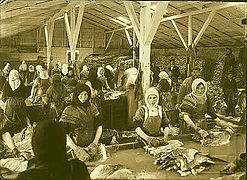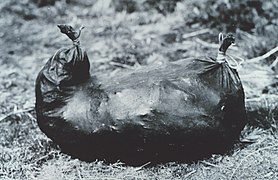Stockfish
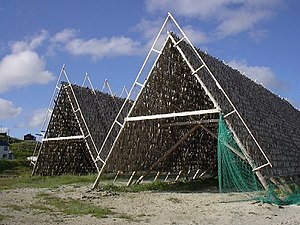
Stockfish is unsalted
Over the centuries, several variants of dried fish have evolved. The stockfish (fresh dried, not salted) category is often mistaken for the klippfisk, or salted cod, category where the fish is salted before drying. Salting was not economically feasible until the 17th century, when cheap salt from southern Europe became available to the maritime nations of northern Europe.
Stockfish is cured in a process called
In English legal records of the medieval period, stock fishmongers are differentiated from ordinary fishmongers when the occupation of a plaintiff or defendant is recorded.[1]
Etymology
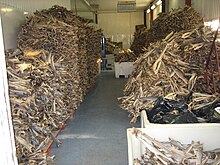
The word stockfish is a
Importance
Stockfish is
Preserved cod fed Iceland for centuries, to the extent that it has been described as a local equivalent of bread.[4]
Stockfish is extremely popular and is widely consumed in Catholic Mediterranean countries, mostly in
Stockfish is a staple of Nigerian cuisine.[8]
Manufacturing and usage
This section needs additional citations for verification. (January 2021) |
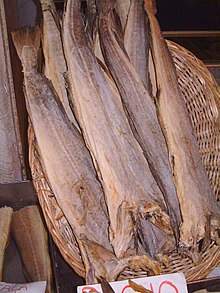
The science of producing good stockfish is in many ways comparable to that of making a good
movement insist that all these artisanal products must be made on a small scale and given time to mature.The fish is prepared immediately after capture. After gutting the fish, it is either dried whole, or split along the spine leaving the tail connected. The fish is hung on the hjell from February to May. Stable cool weather protects the fish from insects and prevents an uncontrolled bacterial growth. A temperature just above zero degrees Celsius, with little rain, is ideal. Too much frost will spoil the fish, as ice destroys the fibers in the fish. The climate in northern Norway is excellent for stockfish production. Due to the stable conditions, the stockfish produced in Lofoten and Vesterålen is often regarded as the best.[citation needed] The traditional cod harvest in Lofoten also takes place during the best drying time. Due to a milder and more humid climate, salted/dried whitefish (klippfisk) was more common in the fisheries districts of Western Norway.
After its three months hanging on the hjell, the fish is then matured for another two to three months indoors in a dry and airy environment. During the drying, about 80% of the water in the fish evaporates..
After sorting by quality, most of the stockfish is exported to Italy, Croatia and Nigeria.[10] In Norway and Iceland, the stockfish is mostly used as a snack and for lutefisk production. In Italy, the fish (called stoccafisso) is soaked and used in various courses, and is viewed as a delicacy.
Low-quality stockfish is also commonly used as supplemental
The 2012–2015 project SafeTrackFood developed a method of indoor production of stockfish to accelerate the maturing and drying of the fish in a safe manner.
Dishes


Baccalà alla vicentina, an ancient and traditional Italian dish native to Vicenza, is made from stockfish (confusingly not from dried and salted cod, although the salted form is known in standard Italian as baccalà), and is served on or next to polenta. In the Italian region of Basilicata, the so-called baccalà alla lucana is prepared with typical peppers called "cruschi" (dialect word for "crispy").[11] In Calabria, stockfish is widely used, especially in the western side of the region: pasta with stockfish is a staple in Christmas Eve.
Dishes made from stockfish (locally called bakalar) are traditionally eaten on Christmas Eve in Croatia, especially Dalmatia.[citation needed]
In Catalonia, stockfish is an ingredient of a kind of surf and turf named es niu.[12]
Stockfish is popular in
Both stockfish and salt cod can be made into lutefisk.[citation needed]
Gallery
-
Cod hung for drying in Lyngen fjord, Norway
-
Stockfish up for drying in Iceland
-
Women working with stock fish in Iceland c. 1915
-
Indian village showing native method of drying salmon, c. 1888.
-
Stomach of a sea lion used byAleut nativesto store dried red salmon
See also
- Boknafisk
- Bugeo– similarly dried Alaska pollock
- List of dried foods
- Lofoten Stockfish Museum
- Yukola, similar fish drying in Russian Far East and Eastern Siberia
Notes
- ^ Plea Rolls of the Court of Common Pleas; Henry VI; in 1460; second entry, first line http://aalt.law.uh.edu/AALT1/H6/CP40no799/aCP40no799fronts/IMG_0704.htm
- OEDs.v. 'stockfish': "the reason for the designation is variously conjectured"
- ISBN 978-90-485-4023-5, retrieved 2024-04-20
- ^ Kurlansky, chapter 9
- ^ "La differenza tra stoccafisso e baccalà". Archived from the original on 2018-12-26.
- ISBN 9781317451600.
- OCLC 25093512.
- ^ "Nigeria's love affair with a Norwegian fish". BBC News. 28 November 2017.
- ^ Kurlansky, chapter 2
- ^ Frederick Forsyth, who covered the 1967-1969 Nigerian Civil War as a reporter, noted that dried fish imports from Norway were a key source of protein for the nation. Forsyth, Frederick. The Outsider: My Life in Intrigue. NY: Putnam, p. 176
- ^ "Salt Cod with Cruschi Peppers". Basilicata cultural society of Canada. 18 August 2012. Retrieved 23 February 2014.
- ^ ES NIU. LA CUISINE IN PALAFRUGELL
References
- Kurlansky, Mark (1997). Cod: A Biography of the Fish That Changed the World. New York: Walker. ISBN 0-8027-1326-2.
- Silva, António J. M. da, In the Shadow of the Salt Cod. Writing vs Staging the Stockfish History in the Iberian Peninsula, TAE - Trabalhos de Antropologia e de Etnologia, vol. 61, 2021, pp. 167–209. PDF
- Great Norwegian Encyclopedia: Tørrfisk



